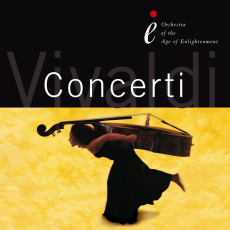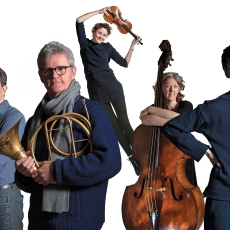Orchestra of the Age of Enlightenment - Vivaldi Concerti - ClassicsToday.com
Artist Quality: 10 / Sound Quality: 10
This is a gem, for many reasons. The easiest first: this is an anthology of Vivaldi at his most captivating. (I suspect it will rightly sell lots of copies through buyers listening to track 1 and instantly breaking out into an enormous grin.) The music is delectable. Some is obscure, some not: the famous La Notte concerto rubs shoulders with some magnificent chamber concertos, one of the more famous oboe concertos, a concerto for lute and viola d'amore, and a magnificent concerto for two utterly shameless horns. The playing is technically assured and dripping with personality, and the sound is clear and fresh. (This doubles as an HDCD for those with the appropriate hardware, of whom I am not one.)
The chamber concertos are for strikingly differentiated ensembles--RV 572 (subtitled Proteus, or the world upside down) bustles endearingly (with a rather bizarre use of the harpsichord as a melody-line solo instrument), while RV 566 foregrounds its soloists in sisterly duets. RV 107, with a solo group of flute, oboe, violin, and bassoon, is an extraordinary find. The slow movement in particular is a voluptuous outpouring of melody on a par with the famous slow movement from the "Winter" concerto of the Four Seasons--an affecting siciliana, with sentimentality kept at bay by an endearingly burbling bassoon line. Vivaldi follows this with a ciaccona finale--in a quick three beats to the bar, carrying on seamlessly from the siciliana (whose slow beats are divided in three) in a magnificent dramatic stroke.
The Concerto for two horns runs against the Vivaldian stereotype. We are perhaps more familiar with Vivaldi's use of less boisterous instruments, and Andrew Clark and Roger Montgomery have a field day here. The booklet notes say rather unfortunately that "the writing may strike present-day listeners, accustomed to the sophisticated mechanism of valve horns, as being unadventurous". Presumably the writer was not given access to a recording of this unabashed romp. In particular, Clark's upper range is magnificent--two top Es in the first 10 seconds giving more than a hint of the jollity to come.
Perhaps one of the finest things about this collection is its rhythmic suppleness. There is not the slightest hint here of the stereotypical "Baroque sewing machine". In place of boringly rigid togetherness there is a flexibility from the entire ensemble that effortlessly animates Vivaldi's seemingly square rhythms. There is plenty of Vivaldi out there that features impeccable ensemble but also makes you wonder why anyone would bother listening to all those 16th-notes. Perhaps, indeed, you may have written Vivaldi off for that reason. If so, look no further.


